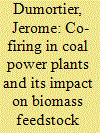| Srl | Item |
| 1 |
ID:
124333


|
|
|
|
|
| Summary/Abstract |
Several states have a renewable portfolio standard (RPS) and allow for biomass co-firing to meet the RPS requirements. In addition, a federal renewable fuel standard (RFS) mandates an increase in cellulosic ethanol production over the next decade. This paper quantifies the effects on local biomass supply and demand of different co-firing policies imposed on 398 existing coal-fired power plants. Our model indicates which counties are most likely to be able to sustain cellulosic ethanol plants in addition to co-firing electric utilities. The simulation incorporates the county-level biomass market of corn stover, wheat straw, switchgrass, and forest residues as well as endogenous crop prices. Our scenarios indicate that there is sufficient feedstock availability in Southern Minnesota, Iowa, and Central Illinois. Significant supply shortages are observed in Eastern Ohio, Western Pennsylvania, and the tri-state area of Illinois, Indiana, and Kentucky which are characterized by a high density of coal-fired power plants with high energy output.
|
|
|
|
|
|
|
|
|
|
|
|
|
|
|
|
| 2 |
ID:
166348


|
|
|
|
|
| Summary/Abstract |
Biomass utilization is a strategy to decrease greenhouse gas (GHG) emissions in the European Union (EU) but bioenergy in the United States (US) is currently limited. As a result, biomass is increasingly exported from the US to the EU, but changes to the policy landscape are poised to alter this. This study utilizes Life Cycle Assessment (LCA) to assess impacts of biomass transportation on bioenergy life cycle GHG emissions. Transportation modes considered include truck, train and sea freight and each are assessed at realistic distances expected in bioenergy supply chains. Emissions for biomass firing alone and co-firing with coal using wood chips and pellets are compared to a baseline coal-fired power plant. Results include life cycle emissions for each case, and sensitivity analysis is presented for variation in power plant efficiency and biomass heating value. A generalized model for estimation of bioenergy emissions is presented. In nearly all cases, biomass utilization for electricity production produces lower life cycle GHG emissions compared to the coal baseline, with emission reductions as high as 76%. Utilization in the US and EU have similar overall emissions at long US distances. Policy implications are discussed in the context of current US and EU policies.
|
|
|
|
|
|
|
|
|
|
|
|
|
|
|
|
| 3 |
ID:
150052


|
|
|
|
|
| Summary/Abstract |
Widespread mortality of forests in the western United States due to a bark beetle epidemic provides a source of biomass for power generation. This study assessed availability and economics of co-firing beetle kill biomass with coal in power plants in the western U.S. Since biomass may be considered carbon neutral under careful management, co-combustion of biomass with coal provides power plants a way to meet emission reduction requirements, such as those in the EPA Clean Power Plan (CPP). Cost has been a barrier to co-firing, but the economics are altered by emission reduction requirements, such as CPP guidelines. The present study assessed beetle kill biomass availability in national forests in Wyoming and Colorado through Geographic Information System (GIS) analysis of U.S. Forest Service (USFS) data. Power plants near beetle kill mortality were identified as candidates for co-firing. An economic assessment of costs to implement co-firing was conducted. Co-firing reduces the need for the USFS to manage beetle kill trees when they are harvested for energy use, and these mitigated treatment costs were considered as an effective subsidy of co-firing. The results of this analysis include beetle kill availability, costs, and annual CO2 emissions reductions that can be met by co-firing.
|
|
|
|
|
|
|
|
|
|
|
|
|
|
|
|